Composer Maury Yeston Playwright Peter Stone | ||
 | ||
Productions 1997 Broadway1999 U.S. Tour2001 Netherlands, Amsterdam2002 Germany, Hamburg2006 Toronto2006 Australia2007 Japan2008 Finland2013 Off-West End2016 Off-West End Awards Tony Award for Best Musical, Tony Award for Best Original Score, Tony Award for Best Book of a Musical Similar Maury Yeston plays, Musicals | ||
Exclusive the full opening of titanic in concert at avery fisher hall
Titanic is a musical with music and lyrics by Maury Yeston and a book by Peter Stone that opened on Broadway in 1997. It won five Tony Awards including the award for Best Musical. Titanic is set on the ocean liner RMS Titanic which sank on its maiden voyage on April 15, 1912.
Contents
- Exclusive the full opening of titanic in concert at avery fisher hall
- godspeed titanic exclusive titanic music video
- Background
- 1997 original Broadway production
- First US National tour
- Chamber Version
- Lincoln Center Staged Concert
- Signature Theatre production
- International productions
- Synopsis
- Characters and original Broadway cast
- Songs
- References
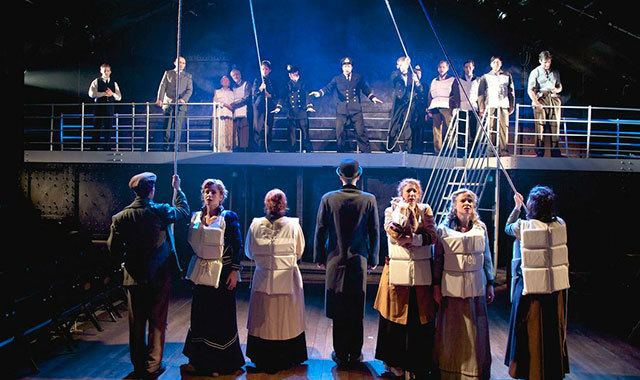
godspeed titanic exclusive titanic music video
Background
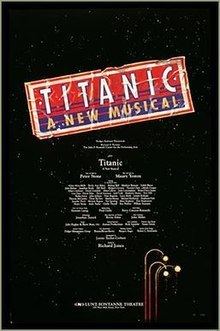
The discovery of the wreck of the RMS Titanic in 1985 attracted Yeston's interest in writing a musical about the famous disaster. "What drew me to the project was the positive aspects of what the ship represented – 1) humankind's striving after great artistic works and similar technological feats, despite the possibility of tragic failure, and 2) the dreams of the passengers on board: 3rd Class, to immigrate to America for a better life; 2nd Class, to live a leisured lifestyle in imitation of the upper classes; 1st Class, to maintain their privileged positions forever. The collision with the iceberg dashed all of these dreams simultaneously, and the subsequent transformation of character of the passengers and crew had, it seemed to me, the potential for great emotional and musical expression onstage."
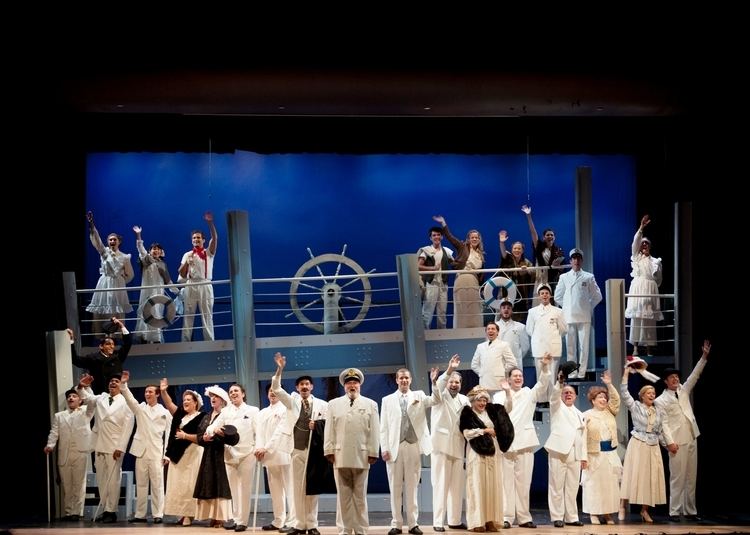
Stone and Yeston knew that the idea was an unusual subject for a musical. "I think if you don't have that kind of daring damn-the-torpedoes, you shouldn't be in this business. It's the safe sounding shows that often don't do well. You have to dare greatly, and I really want to stretch the bounds of the kind of expression in musical theater," Yeston explained. Yeston saw the story as unique to turn-of-the-century British culture, with its rigid social class system and its romanticization of progress through technology. "In order to depict that on the stage, because this is really a very English show, I knew I would have to have a color similar to the one found in the music of the great composers at that time, like Elgar or Vaughan Williams; this was for me an opportunity to bring in the musical theater an element of the symphonic tradition that I think we really haven't had before. That was very exciting."
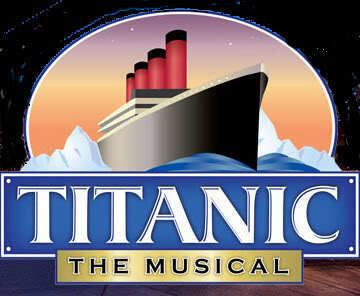
The high cost of Titanic′s set made it impossible for the show to have traditional out of town tryouts. Titanic′s previews began at Broadway's Lunt-Fontanne Theatre in 1997 with major technical troubles: ironically, during previews the model ship onstage would not sink. These difficulties were mostly resolved by opening night, but the show received mostly negative reviews. The New Yorker′s was a rare positive assessment from the New York press: "It seemed a foregone conclusion that the show would be a failure; a musical about history's most tragic maiden voyage, in which fifteen hundred people lost their lives, was obviously preposterous.... Astonishingly, Titanic manages to be grave and entertaining, somber and joyful; little by little you realize that you are in the presence of a genuine addition to American musical theatre."
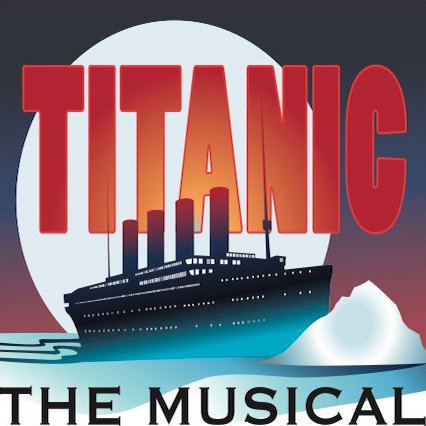
During the previews, the cast had feared the show would close. Michael David, a producer, saw the previews, and Yeston recalls that "We assembled the cast and company in the Lunt-Fontanne Theater's lower lounge, which was one of our rehearsal spaces, and Michael David of the Dodgers laid out a very clear plan. He spoke of what he felt about the show and how the reviews didn't reflect the quality of the performances or the work. He said he knew audiences were telling us the truth. He explained how we were going to advertise to get our message to public. How the ad agency would find those reviews that reflected what the show was really about." Yeston went on to say that, "Yeah, I made a speech in which I expressed from the bottom of my heart the reasons that I write for the musical theater. It was a heartfelt sentimental message to them, many of whom have become my good friends. It was a wonderful moment for all of us to get back to our roots as to why we do this in the first place. For a moment, we got away from all of the false elements of the marketplace: the reviews, Tony competition, all of the things that are secondary to the real reason they as artists and I as composer/lyricist choose to do what we do."
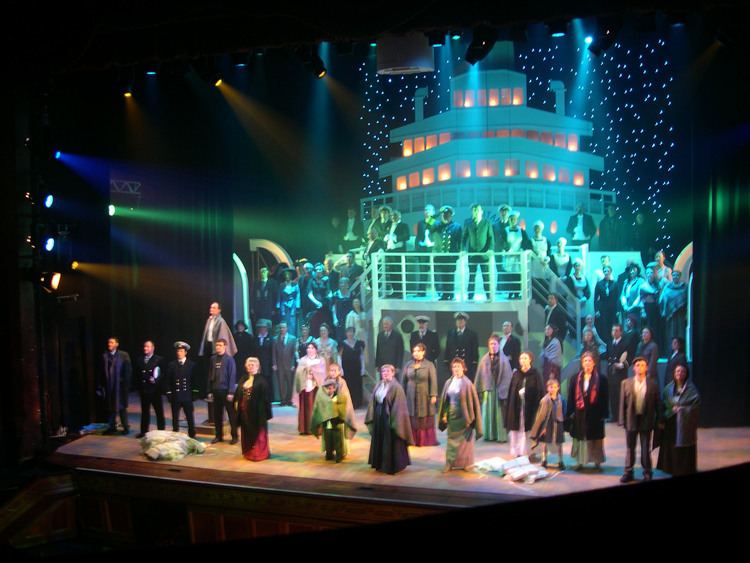
It ran 804 performances but closed at a loss, despite winning five Tony Awards (including Best Musical), the advocacy of Rosie O'Donnell, and the release of James Cameron's film Titanic in December 1997.
1997 original Broadway production
Titanic opened on April 23, 1997 at the Lunt-Fontanne Theatre and ran for 804 performances and 27 previews, closing on March 21, 1999. Directed by Richard Jones with choreography by Lynne Taylor-Corbett, the cast included John Cunningham, David Garrison, Larry Keith, Alma Cuervo, Michael Cerveris, Victoria Clark, Don Stephenson, and Brian d'Arcy James. Danny Burstein was a cast replacement. The set encompassed three levels to help form the impression of the size of the ship. The lobby of the Lunt-Fontanne Theatre was redecorated for the production: the complete passenger list of the Titanic was painted on the walls, noting those who ultimately survived the disaster.
Orchestrator Jonathan Tunick won the first Tony Award for Best Orchestrations for his work on the score. The show received five Tony nominations, winning in all five categories, though the director, Richard Jones, was not nominated, nor were any of the performers.
Stewart Laing was responsible for both the costume design and the scenic design, for which he won a Tony Award for Best Scenic Design. The wardrobe is on display at the Costume World Broadway Collection in Pompano Beach, Florida. Paul Gallo was responsible for the lighting design. Steve Canyon Kennedy was responsible for the sound design.
First US National tour
The production toured the United States after closing on Broadway, beginning in January 1999 at the Ahmanson Theatre in Los Angeles, with a cast that featured Brian d'Arcy James (Los Angeles only), Marcus Chait, and William Parry. There were also several subsequent tours with non-Equity performers.
Chamber Version
In 2012 original Broadway cast member Don Stephenson, who created the part of Charles Clarke, developed a new chamber version of 'Titanic' in collaboration with choreographer Liza Gennaro. This scaled down production used 20 actors playing all of the roles, an abstract set design, projections of the actual ship and passengers, and new orchestrations designed to make the score sound as if it was being played by the ships band. Material that had been previously cut from the original Broadway production was put back into the show, and existing material was reordered and reassigned.. This new intimate version of 'Titanic' opened in July 2012 at The Hangar Theatre. The production was nominated for 11 BroadwayWorld Awards which included Best Musical, Best Director, Best Choreographer, and Best Ensemble performance. Stephenson subsequently remounted this production at Westchester Broadway Theatre in January 2014.
The Griffin Theatre Company in Chicago will produce the first major US production of the new Chamber version. Scheduled Opening is October 26, 2014. Directed by Scott Weinstein with Music Direction by Elizabeth Doran and Choreography by Sawyer Smith.
Lincoln Center Staged Concert
In Feb. of 2014 most of the original Broadway cast reunited for a staged concert of the musical at Lincoln Center's Avery Fisher Hall. This concert was produced by Manhattan Concert Productions and featured a chorus of 200 singers from across the country. It was conducted by original musical director, music supervisor, and conductor Kevin Stites, choreographed by Liza Gennaro, and directed by Don Stephenson.
Signature Theatre production
Arlington, Virginia's Signature Theatre will present Titanic from December 13, 2016 to January 29, 2017. “I've always loved the musical Titanic and I have felt that Signature should reinvent this musical for our audiences in an exciting new way,” said the company's artistic director Eric Schaeffer in an article about the production.
International productions
A Dutch touring production (European premiere) opened on 23 September 2001 in Royal Theatre Carre, Amsterdam. It was also highly successful, and produced an original cast recording (sung in Dutch) as a companion to the original Broadway cast recording on RCA Records. On 7 December 2002, a German production opened in Hamburg, a copy of the Dutch production. A cast recording was made in German. A new song was written for the German production, "Drei Tage" (Three Days), but the song was not included on cast album. It was recorded and released on a German karaoke CD called Professional Playbacks: Showtunes Vol. 1.
On May 17, 2005 the Belfast Operatic Company premiered the show in Ireland in the Grand Opera House, Belfast, Northern Ireland. The Belfast Operatic Company performed the show again, in the Grand Opera House, Belfast, on the week the ship sailed, from 10 April to 14 April 2012, with a special performance beginning at 11:40 pm on the Saturday night, the time which the ship hit the iceberg. Composer Maury Yeston attended two performances of the show, having flown in from New York.
The show's Canadian Premiere was presented in Toronto, by the Toronto Civic Light Opera in February 2006, directed by Joe Cascone, in a newly imagined staging which dispensed with the "slanted set" concept of the original production. This production featured Bob Deutsch as Captain Smith, David Haines as J. Bruce Ismay, and Cory Doran as Barrett. Staged with full orchestra and 40-member cast, the run was extended twice due to popular demand.
The Australian production starring Nick Tate as Captain Smith debuted in October 2006. The same production made its UK premiere at York Theatre Royal, and its London premiere at the Gordon Craig Theatre in Stevenage.
A Japanese engagement played from January to February 2007.
The premiere in Wales was performed 15–20 November 2004 at the Gwyn Hall by Neath Amateur Operatic Society. The musical returned to Wales from 11–14 April 2012 by Spotlight Theatre Company in the Parc and Dare Hall. Directed by Pat Evans, musical direction by Geraint Bessant, the performance included a special gala event on the 14th April to mark 100 years to the day the tragedy struck. The London Premiere was presented by West Wickham Operatic Society between 21–26 November 2006 at The Churchill Theatre Bromley.
On February 9, 2008, Ballinrobe Musical Society, under the direction of Peter Kennedy, performed the first ever production to take place in the Republic of Ireland. The show ran from 9 to 16 February. Michael Coen played Captain Edward Smith.
There were French productions in Belgium in the cities of Liege and Charleroi by Stéphane Laporte and Jean-Louis Grinda from 2000 to 2006. The show premiered in Finland on 29 March 2008 in Seinäjoki City Theatre.
On April 26, 2010, the musical company Scenario premiered the show in Kolbotn, Norway. The show ran from the 26th of April to the 12th of May.
On July 26, 2013, an off west end production opened at the Southwark Playhouse, London. It was the UK premiere for this new chamber arrangement of the score, written for a string quartet, two keys and percussion. Directed by Thom Southerland and produced by Danielle Tarento. The production won various awards, including BroadwayWorld UK Award for Best Leading Actress in a New Production of a Musical (Fringe/Regions) for Celia Graham's portrayal of Alice Beane and Best New Production of a Musical on the Fringe or in the Regions. Alongside Graham, also starred Philip Rham, Simon Green, Greg Castiglioni, James Austen-Murray, Dominic Brewer, Scarlett Courtney, Matthew Crowe, Jonathan David Dudley, Grace Eccle, Oliver Hembrough, James Hume, Sion Lloyd, Claire Marlowe, Shane McDaid, Judith Street, Leo Miles, Nadim Naaman and Victoria Serra. Musical staging is by Cressida Carre, with musical direction by Mark Aspinall, sets and costumes by David Woodhead, lighting by Howard Hudson and sound by Andrew Johnson. The production ran for six weeks and closed on August 31, 2013.
Titanic has been translated into six languages: Japanese, French, Dutch, German, Finnish and Norwegian, and a Danish version is set to premiere in the fall of 2017.
Synopsis
Act 1
Titanic's designer, Thomas Andrews marvels at the wondrous things mankind has accomplished ("In Every Age"); with the R.M.S. Titanic becoming the newest feat once thought impossible. Stoker Fred Barrett arrives at the dock in Southampton, amazed by the feat of engineering ("How Did They Build Titanic?"). He is joined by Lookout Frederick Fleet and wireless telegraph operator Harold Bride, and they gaze in awe at the "Ship of Dreams" ("There She Is") as the crew arrives. J. Bruce Ismay, Andrews, and Captain E. J. Smith congratulate each other on being the owner, designer, and captain of "The Largest Moving Object" in the world. The ship's passengers arrive; the Third and Second Class passengers feel privileged to be aboard the maiden voyage of the grandest ship ever to sail ("I Must Get on that Ship"). The First Class passengers arrive; their names and achievements are narrated by Second Class passenger Alice Beane ("First Class Roster"). The Titanic sets sail, and the assembled company wishes her a safe crossing ("Godspeed Titanic").
Now at sea, Ismay arrives on the bridge to inform Smith that he plans for the Titanic to arrive in New York on Tuesday afternoon rather than Wednesday morning, while Andrews insists that the maiden voyage be a safe one. As they've cleared land, Smith allows her speed to be increased slightly. Barrett, in the boiler room, disagrees with the order on such a new ship, but nonetheless complies ("Barrett's Song").
In Second Class, Alice Beane longs for the grandeur that is First Class, while her husband Edgar, a successful hardware store owner, is content with their station. Charles Clarke, who is traveling to America to become a journalist, is accompanied by his fiancee Caroline Neville. Caroline's father doesn't approve of the engagement, so they are eloping to America. In First Class, the titans of industry recount the accomplishments that man has recently achieved, with the Titanic becoming the pinnacle. ("What a Remarkable Age this Is!"). In steerage, three Irish lasses—each named Kate—dream with the rest of Third Class of the opportunities that await them in America ("Lady's Maid"). Kate McGowan is smitten with a young man traveling with them, Jim Farrell.
As the voyage continues, Ismay demands increasingly more speed, so the ship can build an impressive reputation. Smith complies despite Andrews' objections and warnings of icebergs in their course. Smith hails 1st Officer Murdoch's qualities, deeming him ready to assume a command of his own, but Murdoch feels he is not yet ready to handle the responsibilities of the job ("To Be a Captain").
In the wireless room, Bride is overwhelmed by the passenger's personal messages to be sent, though he finds time to handle Barrett's proposal to his girlfriend ("The Proposal/The Night Was Alive").
On Sunday morning, the First Class attends religious services ("God Lift Me Up"), then dances on deck to "The Latest Rag". Alice Beane has managed to infiltrate their ranks, though she is turned away several times by an alert steward. Edgar finds her and the two argue over their lifestyle choices ("I Have Danced"). As evening draws near, the temperature drops, and lookout Fleet finds the weather conditions difficult for spotting icebergs ("No Moon"). On deck, Kate McGowan tells Farrell that she needs to marry as she is carrying the child of a married man, and he accepts. Elderly passengers Isidor and Ida Straus discuss their plans for the years to come while Charlotte Drake Cardoza scandalizes the First Class men by joining them for cards in the First Class Smoke Room ("Autumn").
Suddenly, Fleet spots an iceberg and alerts the bridge. Murdoch, who's the senior officer on the bridge, takes evasive action, but the Titanic strikes the iceberg.
Act 2
The stewards begin waking the confused passengers, while they themselves do not have much information ("Wake Up, Wake Up"). Capt. Smith arrives on the bridge and is briefed on the situation. He orders all passengers to put on life vests, for Bride to begin sending distress messages, and for Andrews to inspect the damage. Andrews informs Smith and Ismay that the damage inflicted is more than the ship is designed to endure and that the ship will sink, reminding them that there are only enough lifeboats for less than half of the people aboard.
In the First Class Dining Salon, passengers refuse to believe that anything is wrong with the ship and are annoyed at being awakened in the middle of the night ("Dressed in Your Pyjamas in the Grand Salon"). Crew members are assuring them that there is no reason to panic. No one is aware of the ship's growing peril until a food cart rolls on its own, showing the ship's growing tilt. All the passengers and crew members quickly hurry to the lifeboats.
In Third Class, the three Kates and Farrell attempt to find a way up to boat deck, but are unable to until they are assisted by Barrett ("The Staircase"). Smith arrives in the radio room where Bride informs him that only the Carpathia is near enough to help, but is unable to arrive until after the Titanic has sunk. Smith, Andrews, and Ismay argue over responsibility for the disaster ("The Blame").
Women and children are ordered into the lifeboats, while the men are forced to stay behind ("To the Lifeboats"). Murdoch orders Fleet and Barrett into the last lifeboat to help man the oars, but Barrett doesn't know how to row a boat and lets Farrell, who can row, into the boat instead. Barrett bids farewell to his absent girlfriend while the rest of the passengers do the same to their loved ones ("We'll Meet Tomorrow").
The bellboy tells the captain that all the life boats have been launched, those remaining accept their fate. Murdoch tells the Captain that he takes full responsibility for the accident, but Smith forgives him and then laments on how he had gone his entire career without experiencing any accident ("To Be A Captain" (Reprise)). Isidor and Ida Straus (Ida had refused to leave her husband behind) affirm their long-lasting love for one another ("Still"). Andrews, in the first-class smoking room, obsesses over the ship's plans, redesigning her and visualizing the final moments of the souls left aboard as the ship sinks beneath the waves ("Mr. Andrews' Vision").
In the early hours of the morning, the survivors are rescued by the Carpathia. Many of them recount the tragedy of the Titanic, mourning the loss of people and ship. Bride and Ismay, along with several of the survivors, discuss the possibilities that could have prevented the disaster ("The Foundering"). The survivors express hope that they will one day be reunited with their lost loved ones and abandoned dreams ("In Every Age/Finale").
Characters and original Broadway cast
Names to the right are the actors who played the role in the original Broadway cast.
Songs
1Overture / Prologue: In Every Age
2How Did They Build Titanic?
3There She Is
